Red pins are females, blue pins are males.
2015-16 SNOWstorm owls
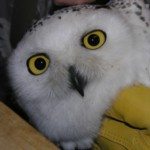 Flanders – 2015
Flanders – 2015
On Dec. 8, 2015, SNOWstorm collaborator (and longtime snowy owl researcher) Tom McDonald of Rochester, NY, caught this adult female on Point Peninsula at the eastern end of Lake Ontario, just a few miles from the New York-Canadian border. Flanders was the first owl of the season and also the first to carry one of Cellular Tracking Technologies’ new 3G transmitters, which (along with a number of other improvements) was significantly more energy efficient than the older models. She spent the winter of 2015-16 on Amherst Island in Lake Ontario, a famous location for snowy owls. (Photo ©Rachael Slate)
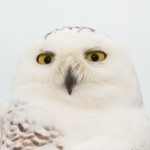 Wampum – 2015
Wampum – 2015
This adult female was originally banded by Norman Smith at Logan AIrport in the winter of 2015-15, then recaptured at Logan the following winter, tagged and released on Cape Cod Dec. 30, 2015. Having spent much of the winter at smaller airports in Rhode Island, she moved back to Logan in mid-March 2016, and was killed by the engine blast from a jet three weeks later — sadly, a not-uncommon fate for owls at large airports. (Photo ©Raymond MacDonald)
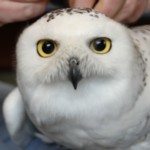 Brunswick – 2016
Brunswick – 2016
This adult female was caught at Brunswick Executive Airport in Brunswick, Maine, by a crew consisting of Scott Weidensaul of Project SNOWstorm and staff from the Biodiversity Research Institute and APHIS Wildlife Services. She was relocated to the Rachel Carson NWR on Jan. 13, 2016. She remained there much of the winter, then shifted south to the Isle of Shoals on the Maine/NH border. Her last contact heading north was April 28, 2016, on the Gaspé Peninsula in Quebec. (Photo ©Rick Gray)
 Salisbury – 2016
Salisbury – 2016
This adult male was originally banded at Logan Airport in Boston by Norman Smith on March 2, 2014. He was recaptured at Logan on Jan. 17, 2016, and relocated to Salisbury Beach State Reservation in Salisbury, MA. He spent the winter along the New England coast, and his last location during his spring migration was on the north shore of the Gulf of St. Lawrence on May 1, 2016. (Photo ©Julie Breheny)
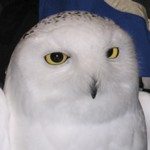 Tibbetts – 2016
Tibbetts – 2016
Tibbetts, an adult male, was tagged Jan. 21, 2016, by Tom McDonald near Cape Vincent, New York, where the St. Lawrence River leaves Lake Ontario — the same area where Tom tagged Chaumont, Flanders and Hardscrabble. Tibbetts shifted northwest to Amherst Island on the Canadian side of the border and moved around northeast Lake Ontario much of the winter. His last transmission on his northbound migration was March 24, 2016, near Ottawa, ON. (Photo ©Tom McDonald)
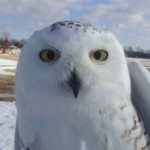 Dakota – 2016
Dakota – 2016
Dakota, an adult female, was originally banded in Michigan on Jan. 16, 2014. She was retrapped on Jan. 31, 2016, by Matt Solensky and Dave Brinker near Jamestown, North Dakota, and fitted with a transmitter — our first North Dakota owl. She wintered close to her trapping point, using large marshes and wetlands, then headed northwest through Manitoba and Saskatchewan, and was last detected north of Regina, SK, on April 22, 2016. (Photo ©Dave Brinker)
 Hardscrabble – 2016
Hardscrabble – 2016
Hardscrabble was an after-third-year male (meaning he was at least four years old) that was tagged Feb. 22, 2016, by Tom McDonald near Hardscrabble Road in Cape Vincent, New York. This almost completely white, unmarked male weighed a robust 1,731 grams and had significant body fat. He moved north through southern and western Quebec, and last checked in April 28, 2016, along the east shore of James Bay. (Photo ©Tom MacDonald)
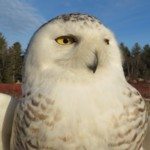 Casco – 2016 –
Casco – 2016 –
Casco, our second Pine Tree State snowy, was trapped at Portland Jetport by Project SNOWstorm partners at the Biodiversity Research Institute and USDA’s Maine Wildlife Services. Casco was released in a huge complex of blueberry barrens in Washington County, about 150 miles (242 km) northeast of the airport. She looped across Maine, New Brunswick and south to Massachusetts, then started north in the spring, last connecting April 21, 2016 on the north shore of the Gulf of St. Lawrence. (Photo ©BRI)
 Merrimack – 2016 –
Merrimack – 2016 –
Merrimack was a third-year female trapped at Logan Airport on March 8, 2016 and released at Salisbury State Reservation at the mouth of the Merrimack River in northern Massachusetts. She remained there for several weeks before making a foray north to Sebago Lake, Maine, then back to the coast, and left for the north April 1, 2016. (Photo ©Raymond MacDonald)
Returning Owls
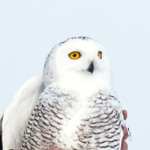 Buena Vista – 2013
Buena Vista – 2013
This young male was banded Dec. 23, 2013, on the Buena Vista grasslands in central Wisconsin. He was the second owl to be tagged with a GPS/GSM transmitter by Project SNOWstorm. Buena Vista, last detected March 31, 2014 while still on his winter territory, checked in again on November 1, 2015 from Manitoba. Due to poor cellular coverage only a small sample of points from his transmitter were received giving a look at his first summer, but we were delighted to see that he spent at least part of it in Nunavut. (©Gene Jacobs)
Baltimore – 2015
This third year male was banded as an immature by Steve Huy after being trapped March 14, 2014 by APHIS Wildlife Services at Martin State Airport in Baltimore, MD, and relocated to western Maryland. Baltimore was recaptured at Martin State Airport on Feb. 13, 2015, fitted with a transmitter and relocated to Assateague Island National Seashore, MD, on Feb. 14, 2015.
Baltimore reappeared Dec. 19, 2015, and his transmitter downloaded 15,000 GPS locations that show he summered (but did not nest) in the northern Ungava Peninsula. He spent the winter of 2015-16 on and around Amherst Island in northeast Lake Ontario, and was last detected March 27, 2016, just north of Lake Ontario.
Baltimore’s transmitter was sponsored by the Baltimore Bird Club. (Photo ©Chris Hudson)
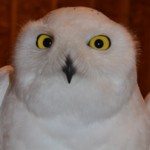 Chaumont – 2015
Chaumont – 2015
This adult male Snowy Owl is nicknamed Chaumont (pronounced “Shaa-moe”), for the small town at the extreme eastern end of Lake Ontario, just a few miles from the Canadian border, where he was captured, and where he has spent most of the winter. His transmitter has operated fitfully, and while we were able to track his current locations (back in the same area of Cape Vincent, NY, where he was trapped) we received little of his backlogged data. (Photo ©Tom McDonald)
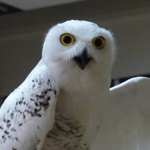 Erie – 2014
Erie – 2014
Erie, then an immature male, was tagged in near the Erie, PA, International Airport on Jan. 19, 2014, along with Millcreek. He was one of several snowy owls in the winter of 2013-14 that spent the majority of their time well offshore, on the frozen surface of the Great Lakes — in his case, Lake Erie — making only occasional visits to land. Erie summered in 2014 along the southern edge of Hudson Bay, and spent the winter of 2014-15 largely on and around southern Lake Huron. In February 2016 he checked in from southern Ontario, but his transmitter malfunctioned, and attempts to trap him and remove it failed.
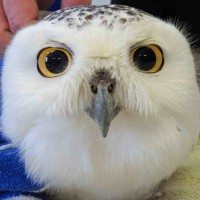 Buckeye – 2015
Buckeye – 2015
This third-year female was captured at Detroit Metropolitan Airport by USDA WIldlife Services and relocated to northwestern Ohio. She was tagged by Mark Shieldcastle from Black Swamp Bird Observatory, and released Feb. 15, 2015, in farmland north of Oak Harbor, OH. Buckeye is part of Project SNOWstorm’s and Wildlife Services’s efforts to learn more about the most effective methods and distances to safely relocate owls from airports. She spent the summer of 2015 on the Boothia Peninsula of northern Nunavut, and the winter of 2015-16 around western Lake Erie. Her transmitter was generously sponsored by Black Swamp Bird Observatory and the Kirtland Bird Club. (Photo ©BSBO)


